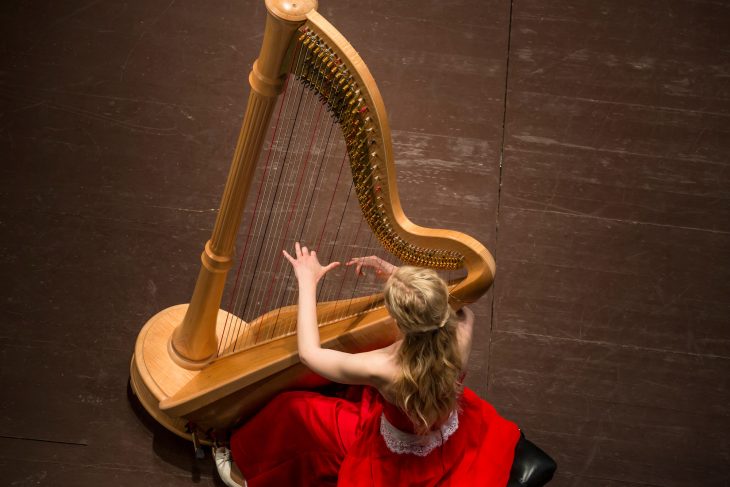
The harp is an instrument that has captured the hearts of musicians and listeners alike for centuries. With its ethereal sound and graceful presence, the harp stands as a symbol of elegance and enchantment. In this article, we delve into the captivating world of harps, unveiling ten intriguing facts that shed light on their history, construction, and the magic they create.
The Oldest Known Stringed Instrument
The harp holds a place of honor as one of the oldest musical instruments known to humankind. Dating back over 5,000 years, the ancient harp can be traced to civilizations such as Ancient Egypt and Mesopotamia. Its enduring popularity is a testament to the instrument’s timeless charm.
Evolving Shapes and Sizes
Harps come in various shapes and sizes, each with its unique character. From the grand concert harp towering over six feet tall to the smaller Celtic harp, these instruments span a wide range. The design and structure of the harp have evolved over time, reflecting the diversity of cultures that embraced its melodic allure.
A Symphony of Strings
One remarkable feature of the harp is its numerous strings. Modern concert harps typically have between 47 to 47 strings, each producing a distinct pitch when plucked. The tension in these strings can exceed 2,000 pounds, requiring precision and skill to tune and play.
Handcrafted with Care
The process of crafting a harp is a labor of love. Skilled artisans meticulously carve, shape, and assemble the instrument’s wooden frame, using materials such as maple, cherry, or mahogany. The delicate strings, often made from nylon or gut, are carefully attached to create an instrument that is both visually stunning and sonically enchanting.
The Pedal Harp’s Ingenious Invention
The pedal harp, also known as the concert harp or orchestral harp, features an ingenious mechanism. Patented in the early 19th century, the pedal system allows harpists to alter the pitch of the strings by pressing pedals with their feet. This innovation expanded the range and versatility of the harp, enabling musicians to perform a wider repertoire of music.
Harp Therapy: Healing Sounds
Beyond its musical prowess, the harp has found its way into therapeutic practices. Harp therapy, a form of sound healing, utilizes the soothing sounds of the instrument to promote relaxation, reduce stress, and aid in emotional and physical well-being. The gentle resonance of the harp has a profound impact on listeners, offering comfort and solace.

The Harp’s Symbolic Significance
The harp has held a deep symbolic meaning throughout history. It is often associated with angelic figures and celestial realms, evoking a sense of transcendence and spiritual connection. In Irish folklore, the harp is a national symbol, representing the soulful melodies of the country’s rich musical heritage.
Harpists: Masters of Multitasking
Playing the harp requires remarkable dexterity and multitasking skills. Harpists must navigate the instrument’s vast array of strings while coordinating hand and foot movements. This intricate coordination demands years of practice, precision, and a deep understanding of music theory.
Harps in Popular Culture
The harp’s allure extends to popular culture, where it often serves as a magical or mystical instrument. In fairy tales and fantasy novels, harps are portrayed as instruments capable of enchanting listeners or granting wishes. They frequently appear in orchestral scores for movies and TV shows, adding a touch of whimsy and ethereal beauty to the soundtrack.
Harp’s Enduring Legacy
Despite its ancient origins, the harp continues to captivate audiences in modern times. It remains a prominent feature in classical music, folk traditions, and contemporary compositions. Harpists around the world showcase their skill and passion, ensuring that this enchanting instrument’s legacy endures for generations to come.
Conclusion
The melodious journey through the world of harps is filled with wonder and enchantment. From its humble beginnings to its intricate craftsmanship and ethereal sounds, the harp has left an indelible mark on the history of music. So, next time you hear the celestial melodies of a harp, let yourself be transported to a world of magic and beauty.
Frequently Asked Questions (FAQs)
What are the different types of harps?
Harps come in various types, including the concert harp, Celtic harp, lever harp, electric harp, and folk harp, each offering unique characteristics and musical possibilities.
How many strings does a harp have?
The number of strings on a harp can vary, but the standard concert harp typically has 47 to 47 strings, spanning several octaves.
Are harps difficult to learn to play?
Playing the harp requires dedication and practice, but with proper instruction and perseverance, anyone can learn to play this enchanting instrument.
Can harps be transported easily?
While concert harps can be large and challenging to transport, smaller harps such as Celtic or lever harps are more portable and suitable for traveling musicians.
Are there any famous harpists?
Yes, there have been many renowned harpists throughout history, including Carlos Salzedo, Nicanor Zabaleta, and Judy Loman, who have made significant contributions to the art of harp playing.
Was this page helpful?
Our commitment to delivering trustworthy and engaging content is at the heart of what we do. Each fact on our site is contributed by real users like you, bringing a wealth of diverse insights and information. To ensure the highest standards of accuracy and reliability, our dedicated editors meticulously review each submission. This process guarantees that the facts we share are not only fascinating but also credible. Trust in our commitment to quality and authenticity as you explore and learn with us.
